University Nursing CVA Case Study: Diagnostic Tests and Planning
VerifiedAdded on 2022/08/25
|6
|1198
|21
Case Study
AI Summary
This CVA case study analyzes a 79-year-old woman presenting with expressive aphasia, left facial droop, and left-sided hemiparesis, suspected of experiencing an acute cerebrovascular accident (CVA). The study explores the role of diagnostic tests like CT and MRI in confirming the diagnosis and differentiating between ischemic and hemorrhagic strokes. It emphasizes the importance of understanding the CVA type for tailored care planning, including medication and oxygen administration. The patient's medical history of paroxysmal atrial fibrillation (PAF) is highlighted as a likely contributor to the stroke. The case study also addresses nursing interventions, including those delegated to assistive personnel, and utilizes the NIHSS score to assess the patient's condition, indicating a moderate severity and the need for acute inpatient rehabilitation.
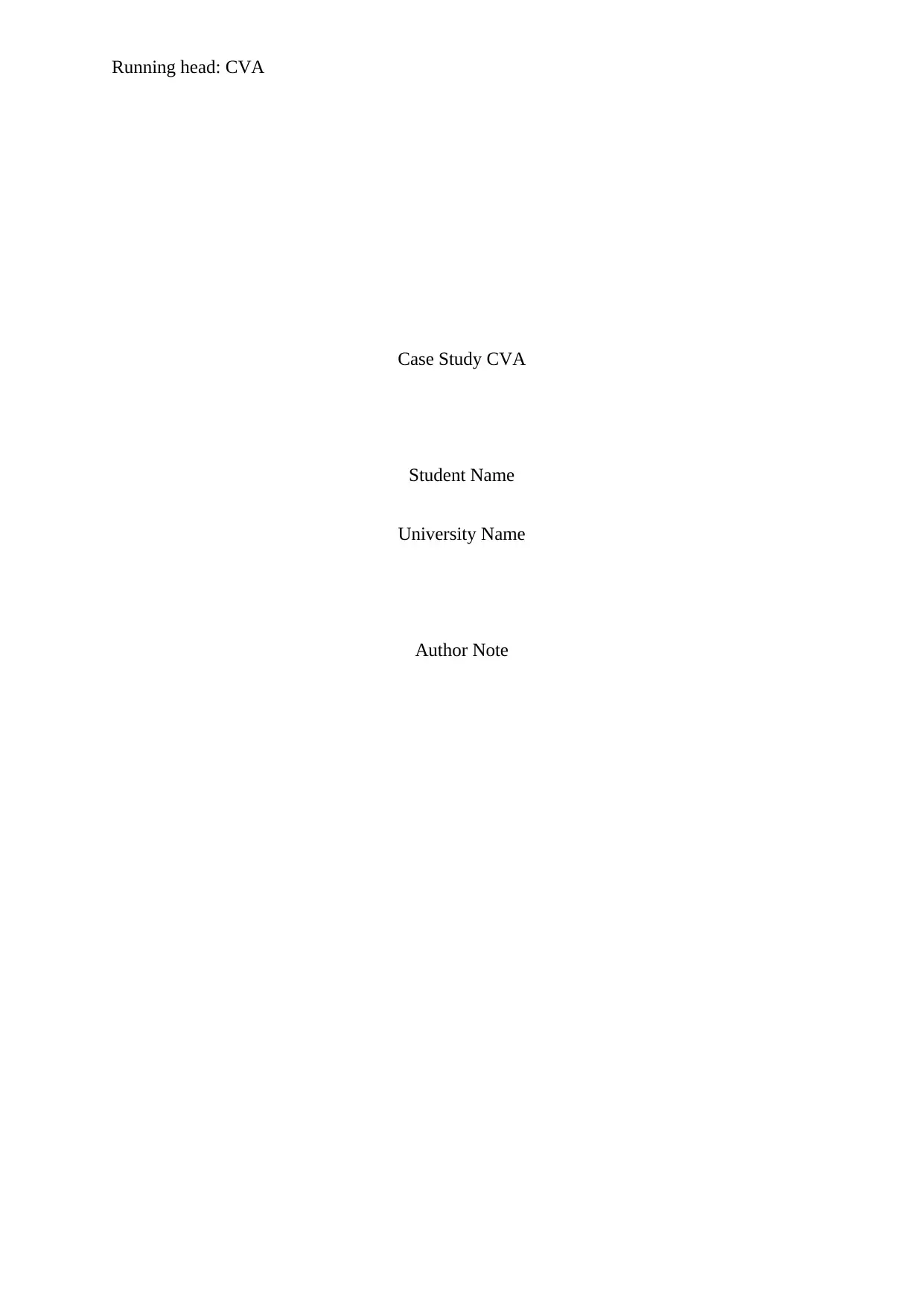
Running head: CVA
Case Study CVA
Student Name
University Name
Author Note
Case Study CVA
Student Name
University Name
Author Note
Paraphrase This Document
Need a fresh take? Get an instant paraphrase of this document with our AI Paraphraser
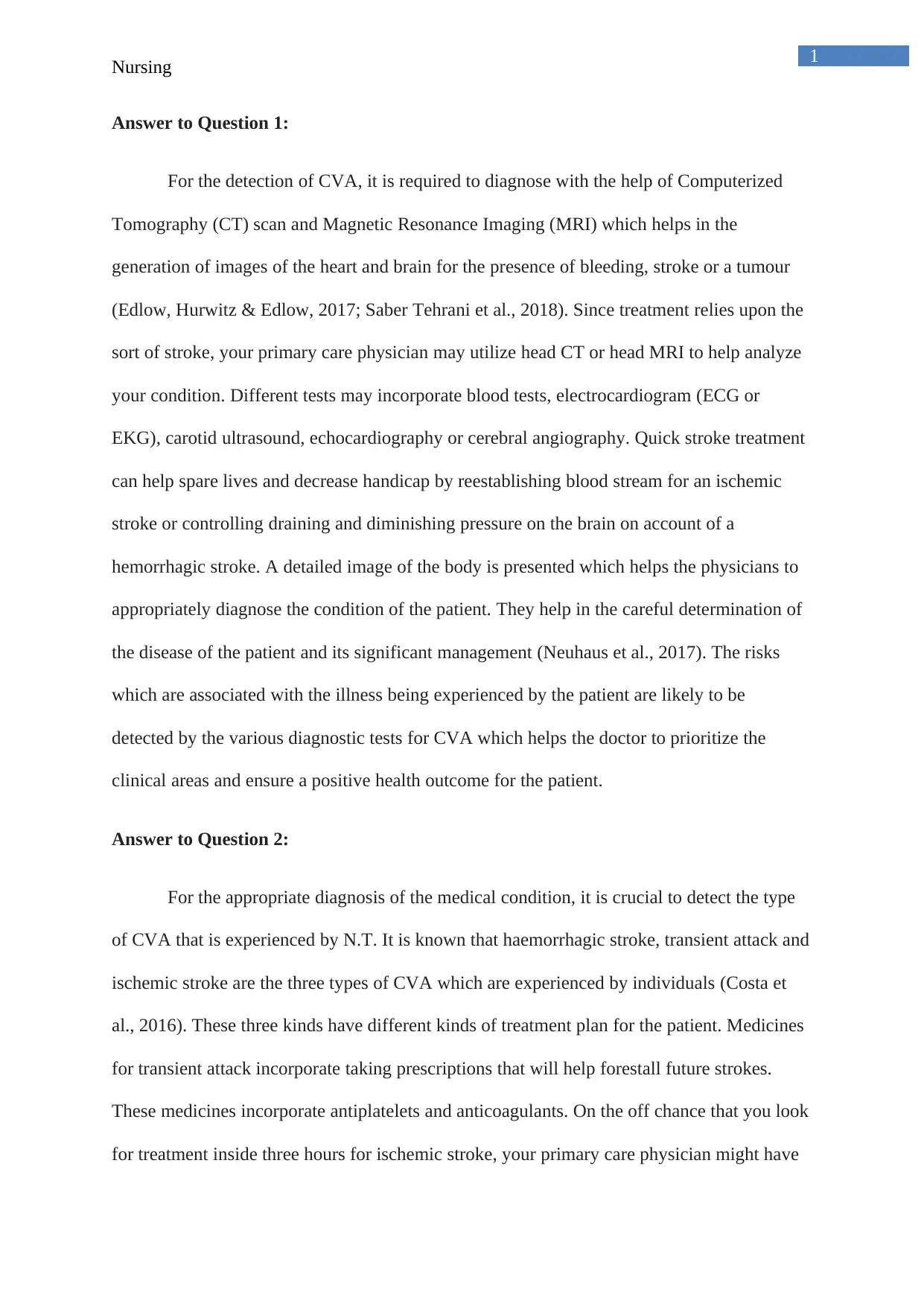
1
Nursing
Answer to Question 1:
For the detection of CVA, it is required to diagnose with the help of Computerized
Tomography (CT) scan and Magnetic Resonance Imaging (MRI) which helps in the
generation of images of the heart and brain for the presence of bleeding, stroke or a tumour
(Edlow, Hurwitz & Edlow, 2017; Saber Tehrani et al., 2018). Since treatment relies upon the
sort of stroke, your primary care physician may utilize head CT or head MRI to help analyze
your condition. Different tests may incorporate blood tests, electrocardiogram (ECG or
EKG), carotid ultrasound, echocardiography or cerebral angiography. Quick stroke treatment
can help spare lives and decrease handicap by reestablishing blood stream for an ischemic
stroke or controlling draining and diminishing pressure on the brain on account of a
hemorrhagic stroke. A detailed image of the body is presented which helps the physicians to
appropriately diagnose the condition of the patient. They help in the careful determination of
the disease of the patient and its significant management (Neuhaus et al., 2017). The risks
which are associated with the illness being experienced by the patient are likely to be
detected by the various diagnostic tests for CVA which helps the doctor to prioritize the
clinical areas and ensure a positive health outcome for the patient.
Answer to Question 2:
For the appropriate diagnosis of the medical condition, it is crucial to detect the type
of CVA that is experienced by N.T. It is known that haemorrhagic stroke, transient attack and
ischemic stroke are the three types of CVA which are experienced by individuals (Costa et
al., 2016). These three kinds have different kinds of treatment plan for the patient. Medicines
for transient attack incorporate taking prescriptions that will help forestall future strokes.
These medicines incorporate antiplatelets and anticoagulants. On the off chance that you look
for treatment inside three hours for ischemic stroke, your primary care physician might have
Nursing
Answer to Question 1:
For the detection of CVA, it is required to diagnose with the help of Computerized
Tomography (CT) scan and Magnetic Resonance Imaging (MRI) which helps in the
generation of images of the heart and brain for the presence of bleeding, stroke or a tumour
(Edlow, Hurwitz & Edlow, 2017; Saber Tehrani et al., 2018). Since treatment relies upon the
sort of stroke, your primary care physician may utilize head CT or head MRI to help analyze
your condition. Different tests may incorporate blood tests, electrocardiogram (ECG or
EKG), carotid ultrasound, echocardiography or cerebral angiography. Quick stroke treatment
can help spare lives and decrease handicap by reestablishing blood stream for an ischemic
stroke or controlling draining and diminishing pressure on the brain on account of a
hemorrhagic stroke. A detailed image of the body is presented which helps the physicians to
appropriately diagnose the condition of the patient. They help in the careful determination of
the disease of the patient and its significant management (Neuhaus et al., 2017). The risks
which are associated with the illness being experienced by the patient are likely to be
detected by the various diagnostic tests for CVA which helps the doctor to prioritize the
clinical areas and ensure a positive health outcome for the patient.
Answer to Question 2:
For the appropriate diagnosis of the medical condition, it is crucial to detect the type
of CVA that is experienced by N.T. It is known that haemorrhagic stroke, transient attack and
ischemic stroke are the three types of CVA which are experienced by individuals (Costa et
al., 2016). These three kinds have different kinds of treatment plan for the patient. Medicines
for transient attack incorporate taking prescriptions that will help forestall future strokes.
These medicines incorporate antiplatelets and anticoagulants. On the off chance that you look
for treatment inside three hours for ischemic stroke, your primary care physician might have
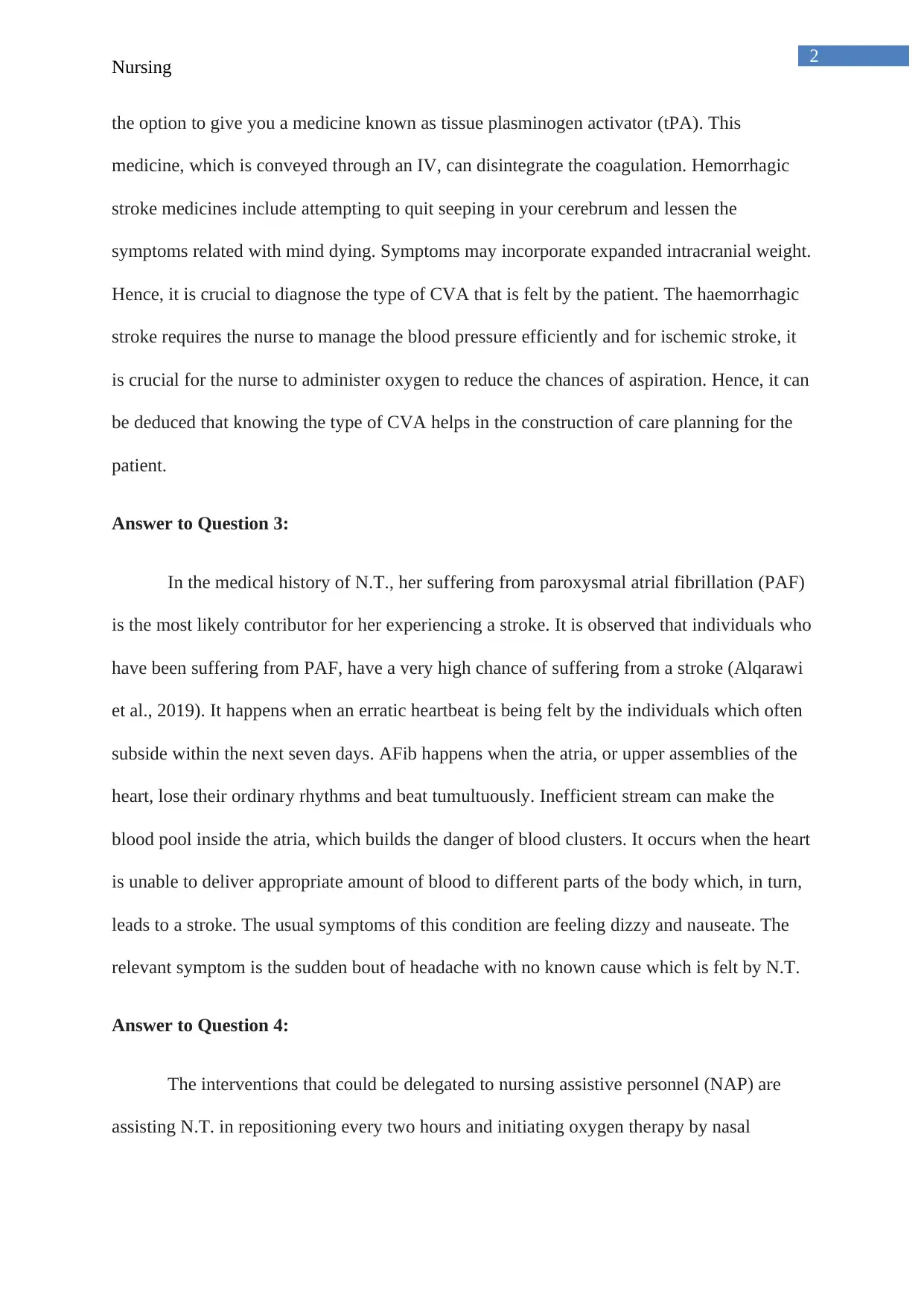
2
Nursing
the option to give you a medicine known as tissue plasminogen activator (tPA). This
medicine, which is conveyed through an IV, can disintegrate the coagulation. Hemorrhagic
stroke medicines include attempting to quit seeping in your cerebrum and lessen the
symptoms related with mind dying. Symptoms may incorporate expanded intracranial weight.
Hence, it is crucial to diagnose the type of CVA that is felt by the patient. The haemorrhagic
stroke requires the nurse to manage the blood pressure efficiently and for ischemic stroke, it
is crucial for the nurse to administer oxygen to reduce the chances of aspiration. Hence, it can
be deduced that knowing the type of CVA helps in the construction of care planning for the
patient.
Answer to Question 3:
In the medical history of N.T., her suffering from paroxysmal atrial fibrillation (PAF)
is the most likely contributor for her experiencing a stroke. It is observed that individuals who
have been suffering from PAF, have a very high chance of suffering from a stroke (Alqarawi
et al., 2019). It happens when an erratic heartbeat is being felt by the individuals which often
subside within the next seven days. AFib happens when the atria, or upper assemblies of the
heart, lose their ordinary rhythms and beat tumultuously. Inefficient stream can make the
blood pool inside the atria, which builds the danger of blood clusters. It occurs when the heart
is unable to deliver appropriate amount of blood to different parts of the body which, in turn,
leads to a stroke. The usual symptoms of this condition are feeling dizzy and nauseate. The
relevant symptom is the sudden bout of headache with no known cause which is felt by N.T.
Answer to Question 4:
The interventions that could be delegated to nursing assistive personnel (NAP) are
assisting N.T. in repositioning every two hours and initiating oxygen therapy by nasal
Nursing
the option to give you a medicine known as tissue plasminogen activator (tPA). This
medicine, which is conveyed through an IV, can disintegrate the coagulation. Hemorrhagic
stroke medicines include attempting to quit seeping in your cerebrum and lessen the
symptoms related with mind dying. Symptoms may incorporate expanded intracranial weight.
Hence, it is crucial to diagnose the type of CVA that is felt by the patient. The haemorrhagic
stroke requires the nurse to manage the blood pressure efficiently and for ischemic stroke, it
is crucial for the nurse to administer oxygen to reduce the chances of aspiration. Hence, it can
be deduced that knowing the type of CVA helps in the construction of care planning for the
patient.
Answer to Question 3:
In the medical history of N.T., her suffering from paroxysmal atrial fibrillation (PAF)
is the most likely contributor for her experiencing a stroke. It is observed that individuals who
have been suffering from PAF, have a very high chance of suffering from a stroke (Alqarawi
et al., 2019). It happens when an erratic heartbeat is being felt by the individuals which often
subside within the next seven days. AFib happens when the atria, or upper assemblies of the
heart, lose their ordinary rhythms and beat tumultuously. Inefficient stream can make the
blood pool inside the atria, which builds the danger of blood clusters. It occurs when the heart
is unable to deliver appropriate amount of blood to different parts of the body which, in turn,
leads to a stroke. The usual symptoms of this condition are feeling dizzy and nauseate. The
relevant symptom is the sudden bout of headache with no known cause which is felt by N.T.
Answer to Question 4:
The interventions that could be delegated to nursing assistive personnel (NAP) are
assisting N.T. in repositioning every two hours and initiating oxygen therapy by nasal
⊘ This is a preview!⊘
Do you want full access?
Subscribe today to unlock all pages.

Trusted by 1+ million students worldwide
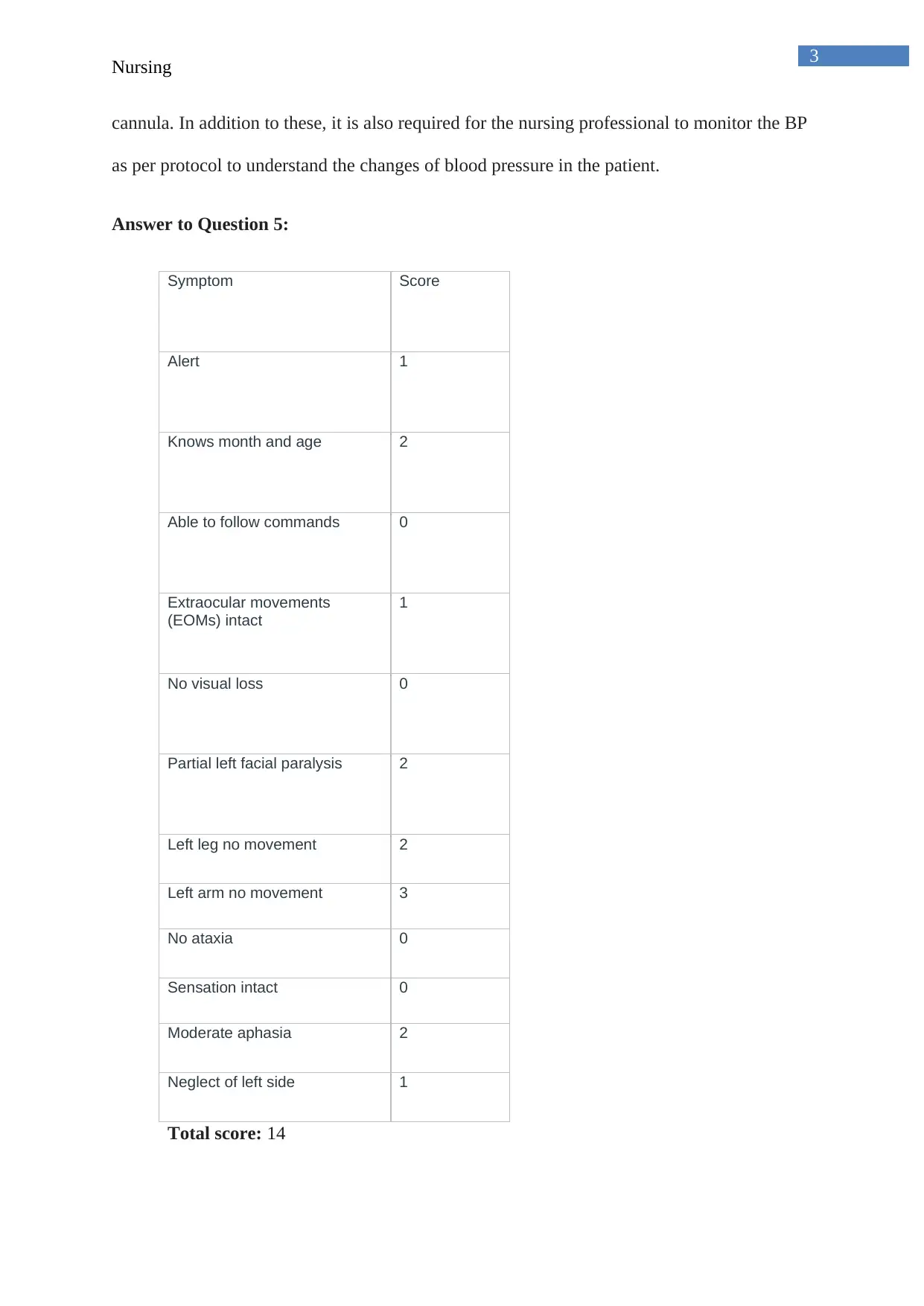
3
Nursing
cannula. In addition to these, it is also required for the nursing professional to monitor the BP
as per protocol to understand the changes of blood pressure in the patient.
Answer to Question 5:
Symptom Score
Alert 1
Knows month and age 2
Able to follow commands 0
Extraocular movements
(EOMs) intact
1
No visual loss 0
Partial left facial paralysis 2
Left leg no movement 2
Left arm no movement 3
No ataxia 0
Sensation intact 0
Moderate aphasia 2
Neglect of left side 1
Total score: 14
Nursing
cannula. In addition to these, it is also required for the nursing professional to monitor the BP
as per protocol to understand the changes of blood pressure in the patient.
Answer to Question 5:
Symptom Score
Alert 1
Knows month and age 2
Able to follow commands 0
Extraocular movements
(EOMs) intact
1
No visual loss 0
Partial left facial paralysis 2
Left leg no movement 2
Left arm no movement 3
No ataxia 0
Sensation intact 0
Moderate aphasia 2
Neglect of left side 1
Total score: 14
Paraphrase This Document
Need a fresh take? Get an instant paraphrase of this document with our AI Paraphraser
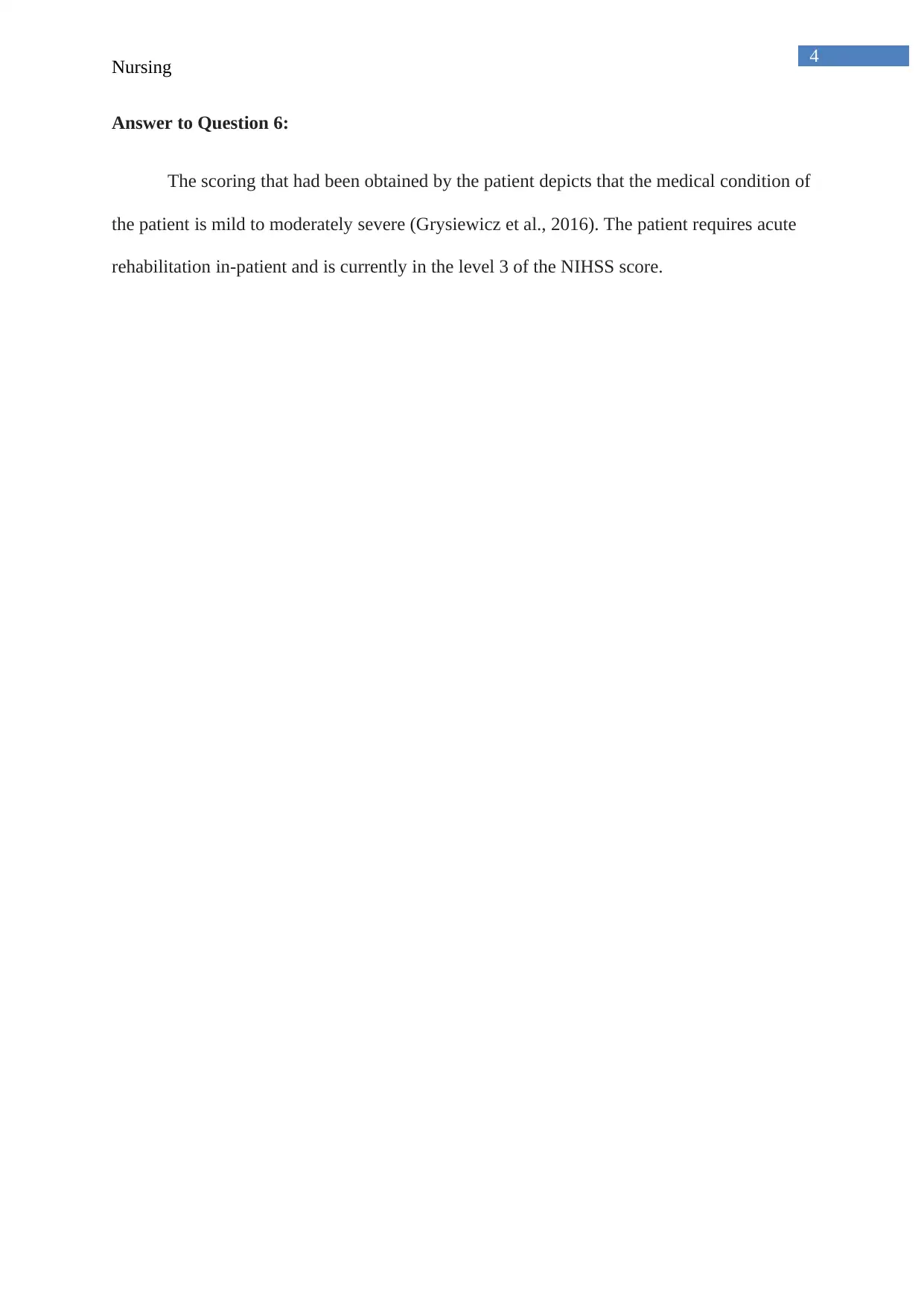
4
Nursing
Answer to Question 6:
The scoring that had been obtained by the patient depicts that the medical condition of
the patient is mild to moderately severe (Grysiewicz et al., 2016). The patient requires acute
rehabilitation in-patient and is currently in the level 3 of the NIHSS score.
Nursing
Answer to Question 6:
The scoring that had been obtained by the patient depicts that the medical condition of
the patient is mild to moderately severe (Grysiewicz et al., 2016). The patient requires acute
rehabilitation in-patient and is currently in the level 3 of the NIHSS score.
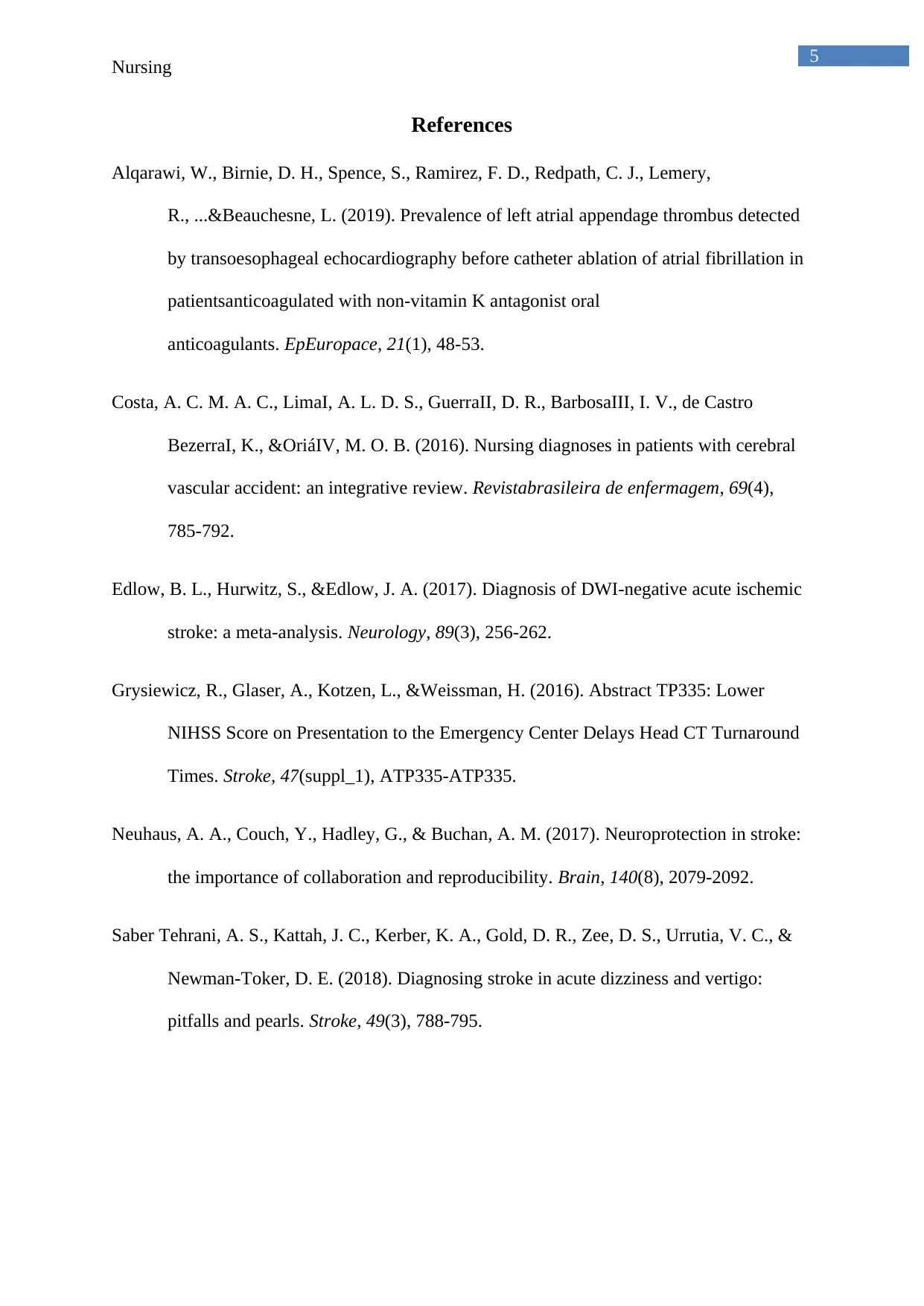
5
Nursing
References
Alqarawi, W., Birnie, D. H., Spence, S., Ramirez, F. D., Redpath, C. J., Lemery,
R., ...&Beauchesne, L. (2019). Prevalence of left atrial appendage thrombus detected
by transoesophageal echocardiography before catheter ablation of atrial fibrillation in
patientsanticoagulated with non-vitamin K antagonist oral
anticoagulants. EpEuropace, 21(1), 48-53.
Costa, A. C. M. A. C., LimaI, A. L. D. S., GuerraII, D. R., BarbosaIII, I. V., de Castro
BezerraI, K., &OriáIV, M. O. B. (2016). Nursing diagnoses in patients with cerebral
vascular accident: an integrative review. Revistabrasileira de enfermagem, 69(4),
785-792.
Edlow, B. L., Hurwitz, S., &Edlow, J. A. (2017). Diagnosis of DWI-negative acute ischemic
stroke: a meta-analysis. Neurology, 89(3), 256-262.
Grysiewicz, R., Glaser, A., Kotzen, L., &Weissman, H. (2016). Abstract TP335: Lower
NIHSS Score on Presentation to the Emergency Center Delays Head CT Turnaround
Times. Stroke, 47(suppl_1), ATP335-ATP335.
Neuhaus, A. A., Couch, Y., Hadley, G., & Buchan, A. M. (2017). Neuroprotection in stroke:
the importance of collaboration and reproducibility. Brain, 140(8), 2079-2092.
Saber Tehrani, A. S., Kattah, J. C., Kerber, K. A., Gold, D. R., Zee, D. S., Urrutia, V. C., &
Newman-Toker, D. E. (2018). Diagnosing stroke in acute dizziness and vertigo:
pitfalls and pearls. Stroke, 49(3), 788-795.
Nursing
References
Alqarawi, W., Birnie, D. H., Spence, S., Ramirez, F. D., Redpath, C. J., Lemery,
R., ...&Beauchesne, L. (2019). Prevalence of left atrial appendage thrombus detected
by transoesophageal echocardiography before catheter ablation of atrial fibrillation in
patientsanticoagulated with non-vitamin K antagonist oral
anticoagulants. EpEuropace, 21(1), 48-53.
Costa, A. C. M. A. C., LimaI, A. L. D. S., GuerraII, D. R., BarbosaIII, I. V., de Castro
BezerraI, K., &OriáIV, M. O. B. (2016). Nursing diagnoses in patients with cerebral
vascular accident: an integrative review. Revistabrasileira de enfermagem, 69(4),
785-792.
Edlow, B. L., Hurwitz, S., &Edlow, J. A. (2017). Diagnosis of DWI-negative acute ischemic
stroke: a meta-analysis. Neurology, 89(3), 256-262.
Grysiewicz, R., Glaser, A., Kotzen, L., &Weissman, H. (2016). Abstract TP335: Lower
NIHSS Score on Presentation to the Emergency Center Delays Head CT Turnaround
Times. Stroke, 47(suppl_1), ATP335-ATP335.
Neuhaus, A. A., Couch, Y., Hadley, G., & Buchan, A. M. (2017). Neuroprotection in stroke:
the importance of collaboration and reproducibility. Brain, 140(8), 2079-2092.
Saber Tehrani, A. S., Kattah, J. C., Kerber, K. A., Gold, D. R., Zee, D. S., Urrutia, V. C., &
Newman-Toker, D. E. (2018). Diagnosing stroke in acute dizziness and vertigo:
pitfalls and pearls. Stroke, 49(3), 788-795.
⊘ This is a preview!⊘
Do you want full access?
Subscribe today to unlock all pages.

Trusted by 1+ million students worldwide
1 out of 6
Related Documents
Your All-in-One AI-Powered Toolkit for Academic Success.
+13062052269
info@desklib.com
Available 24*7 on WhatsApp / Email
![[object Object]](/_next/static/media/star-bottom.7253800d.svg)
Unlock your academic potential
Copyright © 2020–2025 A2Z Services. All Rights Reserved. Developed and managed by ZUCOL.




